Trends in Research on Soil Organic Nitrogen over the Past 20 Years
Abstract
1. Introduction
2. Methods
2.1. Data Sources
2.2. Data Analysis
3. Results and Discussion
3.1. Overall Status of SON
3.2. Co-Occurrence Analysis of Journals
3.3. Co-Occurrence Analysis of Authors
3.4. Collaboration Network Analysis of Countries and Institutions
3.5. Research Hotspots
4. Conclusions
Author Contributions
Funding
Data Availability Statement
Acknowledgments
Conflicts of Interest
References
- An, Y.; Gao, Y.; Liu, X.; Tong, S.; Liu, B.; Song, T.; Qi, Q. Soil Organic Carbon and Nitrogen Variations with Vegetation Succession in Passively Restored Freshwater Wetlands. Wetlands 2021, 41, 1–10. [Google Scholar] [CrossRef]
- Al-Kaisi, M.M.; Yin, X.H.; Licht, M.A. Soil carbon and nitrogen changes as affected by tillage system and crop biomass in a corn-soybean rotation. Appl. Soil Ecol. 2005, 30, 174–191. [Google Scholar] [CrossRef]
- Zhang, D.; Cai, X.; Diao, L.; Wang, Y.; Wang, J.; An, S.; Cheng, X.; Yang, W. Changes in soil organic carbon and nitrogen pool sizes, dynamics, and biochemical stability during ~160 years natural vegetation restoration on the Loess Plateau, China. Catena 2022, 211, 106014. [Google Scholar] [CrossRef]
- Dong, S.H.; He, Z.M.; Wang, W.Q.; Zhang, X.-C.; Feng, Z.; He, H.-B.; Zhang, X.-D.; Zhang, W. Interannual variation of soil organic nitrogen fractions and their responses to straw returning. Chin. J. Appl. Ecol. 2022, 33, 2963–2970. [Google Scholar]
- Wang, R.; Li, S.; Zhang, X.; Li, S.; Shao, M. Difference of soil organic nitrogen components and microbial biomass nitrogen under different eco-system in northwestern China. Agric. Res. Arid Areas 2004, 22, 21–27. [Google Scholar]
- Prieto-Fernandez, A.; Carballas, T. Soil organic nitrogen composition in Pinus forest acid soils: Variability and bioavailability. Biol. Fertil. Soils 2000, 32, 177–185. [Google Scholar] [CrossRef]
- Olk, D.C.; Cassman, K.G.; Schmidt-Rohr, K.; Anders, M.M.; Mao, J.-D.; Deenik, J.L. Chemical stabilization of soil organic nitrogen by phenolic lignin residues in anaerobic agroecosystems. Soil Biol. Biochem. 2006, 38, 3303–3312. [Google Scholar] [CrossRef]
- Ren, J.C.; Zhang, P.J.; Pan, G.X.; Song, L. Indices of eco-geochemical characteristics in a degradation sequence of soils in mountainous Karst area. Adv. Earth Sci. 2006, 21, 504–512. [Google Scholar]
- Zhao, T.; Zhang, J.H.; Wang, F.; Geng, S. Controlling factors and spatial distribution of gross N transformation rate of global forest. Chin. J. Ecol. 2018, 37, 3746–3756. [Google Scholar]
- Sjögersten, S.; Wookey, P.A. The Role of Soil Organic Matter Quality and Physical Environment for Nitrogen Mineralization at the Forest-Tundra Ecotone in Fennoscandia. Arct. Antarct. Alp. Res. 2005, 37, 118–126. [Google Scholar] [CrossRef]
- Hobbie, S.E. Plant species effects on nutrient cycling: Revisiting litter feedbacks. Trends Ecol. Evol. 2015, 30, 357–363. [Google Scholar] [CrossRef]
- Karagatzides, J.D.; Butler, J.L.; Ellison, A.M. The Pitcher Plant Sarracenia purpurea Can Directly Acquire Organic Nitrogen and Short-Circuit the Inorganic Nitrogen Cycle. PLoS ONE 2009, 4, e6164. [Google Scholar] [CrossRef] [PubMed]
- Fine, A.K.; Schmidt, M.P.; Martinez, C.E. Nitrogen-rich compounds constitute an increasing proportion of organic matter with depth in O-i-O-e-O-a-A horizons of temperate forests. Geoderma 2018, 323, 1–12. [Google Scholar] [CrossRef]
- He, Y.; Zhang, C.; Xue, T.; Chen, X.; Fu, Y. Effects of land-use changes on soil organic nitrogen fractions in the black soil region of Northeast China. Soil Use Manag. 2023, 39, 805–816. [Google Scholar] [CrossRef]
- Paillet, Y.; Bergès, L.; Hjältén, J.; Ódor, P.; Avon, C.; Bernhardt-Römermann, M.; Bijlsma, R.; De Bruyn, L.; Fuhr, M.; Grandin, U.; et al. Biodiversity Differences between Managed and Unmanaged Forests: Meta-Analysis of Species Richness in Europe. Conserv. Biol. 2010, 24, 101–112. [Google Scholar] [CrossRef]
- Liu, X.; Jiang, N.; Jing, G.; Wang, S.; Chen, E.; Zhang, Y. Amending biochar affected enzyme activities and nitrogen turnover in Phaeozem and Luvisol. Glob. Change Biol. Bioenergy 2023, 15, 954–968. [Google Scholar] [CrossRef]
- Ju, X.; Liu, X.; Zhang, F. Effects of Long-term Fertilization on Soil Organic Nitrogen Fractions. Sci. Agric. Sin. 2004, 37, 87–91. [Google Scholar]
- Weiwei, X.; Xiaohui, F.A.N.; Linzhang, Y.; Mingde, H.A.O. Response of Soil Organic Nitrogen Forms and Organic Carbon to Long-term Fertilization in Dry Highland of Loess Plateau. J. Agro-Environ. Sci. 2007, 26, 672–675. [Google Scholar]
- Jafarian, Z.; Kavian, A. Effects of Land-Use Change on Soil Organic Carbon and Nitrogen. Commun. Soil Sci. Plant Anal. 2013, 44, 339–346. [Google Scholar] [CrossRef]
- Mulvaney, R.L.; Khan, S.A.; Hoeft, R.G.; Brown, H.M. A soil organic nitrogen fraction that reduces the need for nitrogen fertilization. Soil Sci. Soc. Am. J. 2001, 65, 1164–1172. [Google Scholar] [CrossRef]
- Norby, R.J.; Ogle, K.; Curtis, P.S.; Badeck, F.W.; Huth, A.; Hurtt, G.C.; Kohyama, T.; Peñuelas, J. Aboveground growth and competition in forest gap models: An analysis for studies of climatic change. Clim. Change 2001, 51, 415–447. [Google Scholar] [CrossRef]
- Hong, T.; Feng, X.Z.; Tong, W.W.; Xu, W.D. Bibliometric analysis of research on the trends in autophagy. PeerJ 2019, 7, e7103. [Google Scholar] [CrossRef] [PubMed]
- Huang, L.; Zhou, M.; Lv, J.; Chen, K. Trends in global research in forest carbon sequestration: A bibliometric analysis. J. Clean. Prod. 2020, 252, 1199008. [Google Scholar] [CrossRef]
- Li, C.; Zong, Z.; Qie, H.; Fang, Y.; Liu, Q. CiteSpace and Bibliometric Analysis of Published Research on Forest Ecosystem Services for the Period 2018–2022. Land 2023, 12, 845. [Google Scholar] [CrossRef]
- Chen, M.; Xu, J.; Li, Z.; Li, D.; Wang, Q.; Zhou, Y.; Guo, W.; Ma, D.; Zhang, J.; Zhao, B. Long-term nitrogen fertilization-induced enhancements of acid hydrolyzable nitrogen are mainly regulated by the most vital microbial taxa of keystone species and enzyme activities. Sci. Total Environ. 2023, 874, 162463. [Google Scholar] [CrossRef] [PubMed]
- Cameron, B.D. Trends in the usage of ISI bibliometric data: Uses, abuses, and implications. Portal Libr. Acad. 2005, 5, 105–125. [Google Scholar] [CrossRef]
- Falagas, M.E.; Papastamataki, P.A.; Bliziotis, I.A. A bibliometric analysis of research productivity in Parasitology by different world regions during a 9-year period (1995-2003). BMC Infect. Dis. 2006, 6, 56. [Google Scholar] [CrossRef]
- Chirici, G. Assessing the scientific productivity of Italian forest researchers using the Web of Science, SCOPUS and SCIMAGO databases. Iforest Biogeosci. For. 2012, 5, 101. [Google Scholar] [CrossRef]
- Li, W.; Zhao, Y. Bibliometric analysis of global environmental assessment research in a 20-year period. Environ. Impact Assess. Rev. 2015, 50, 158–166. [Google Scholar] [CrossRef]
- Wu, X.; Shen, Y.-S. The Bibliometric Analysis of Low-Carbon Transition and Public Awareness. Atmosphere 2023, 14, 970. [Google Scholar] [CrossRef]
- Vieira, R.A.; McManus, C. Bibliographic mapping of animal genetic resources and climate change in farm animals. Trop. Anim. Health Prod. 2023, 55, 259. [Google Scholar] [CrossRef] [PubMed]
- Bouyssou, D.; Marchant, T. Consistent bibliometric rankings of authors and of journals. J. Informetr. 2010, 4, 365–378. [Google Scholar] [CrossRef][Green Version]
- Abramo, G.; D’Angelo, C.A. Assessing national strengths and weaknesses in research fields. J. Informetr. 2014, 8, 766–775. [Google Scholar] [CrossRef]
- Aleixandre-Benavent, R.; Aleixandre-Tudo, J.L.; Castello-Cogollos, L.; Aleixandre, J.L. Trends in scientific research on climate change in agriculture and forestry subject areas(2005–2014). J. Clean. Prod. 2017, 147, 406e418. [Google Scholar] [CrossRef]
- Liu, W.; Wang, J.; Li, C.; Chen, B.; Sun, Y. Using bibliometric analysis to understand the recent progress in agroecosystem services research. Ecol. Econ. 2019, 156, 293e305. [Google Scholar] [CrossRef]
- Wang, Z.H.; Zhao, Y.D.; Wang, B. A bibliometric analysis of climate change adaptation based on massive research literature data. J. Clean. Prod. 2018, 199, 1072–1082. [Google Scholar] [CrossRef]
- Ekundayo, T.C.; Okoh, A.I. A global bibliometric analysis of Plesiomonas-relatedresearch (1990–2017). PLoS ONE 2018, 13, e0207655. [Google Scholar] [CrossRef]
- Sharifi, A.; Khavarian-Garmsir, A.R.; Allam, Z.; Asadzadeh, A. Progress and prospects in planning: A bibliometric review of literature in Urban Studies and Regional and Urban Planning, 1956-2022. Prog. Plan. 2023, 173, 100740. [Google Scholar] [CrossRef]
- Shiffrin, R.M.; Börner, K. Mapping knowledge domains. Proc. Natl. Acad. Sci. USA 2004, 101, 5183–5185. [Google Scholar] [CrossRef]
- Chen, Y.; Liu, Z.Y.; Chen, J.; Hou, J.H. History and theory of mapping knowl-edge domains. Stud. Sci. Sci. 2008, 26, 449–460. (In Chinese) [Google Scholar]
- Cradock-Henry, N.A.; Kirk, N.; Ricart, S.; Diprose, G.; Kannemeyer, R. Decisions, options, and actions in the face of uncertainty: A systematic bibliometric and thematic review of climate adaptation pathways. Environ. Res. Lett. 2023, 18, 073002. [Google Scholar] [CrossRef]
- Xu, Q.-F.; Xia, Y.; Li, S.-J.; Wang, W.-Z.; Li, Z. Temporal and Spatial Distribution Characteristics and Source Analysis of Nitrate in Surface Water of Wuding River Basin. Huan Jing Ke Xue = Huanjing Kexue 2023, 44, 3174–3183. [Google Scholar]
- Bansal, S.; Yin, X.; Sykes, V.; Lee, J.; Jagadamma, S. Soil aggregate-associated organic carbon and nitrogen response to long-term no-till crop rotation, cover crop, and manure application. Soil Sci. Soc. Am. J. 2021, 85, 2169–2184. [Google Scholar] [CrossRef]
- Barre, P.; Durand, H.; Chenu, C.; Meunier, P.; Montagne, D.; Castel, G.; Billiou, D.; Soucémarianadin, L.; Cécillon, L. Geological control of soil organic carbon and nitrogen stocks at the landscape scale. Geoderma 2017, 285, 50–56. [Google Scholar] [CrossRef]
- Bo, S.U.N.; Ge, S. Review on Soil Organic Nitrogen Transport at Regional Scale. J. Agro-Environ. Sci. 2006, 25, 549–553. [Google Scholar]
- Evrendilek, F.; Berberoglu, S.; Taskinsu-Meydan, S.; Yilmaz, E. Quantifying carbon budgets of conifer Mediterranean forest ecosystems, Turkey. Environ. Monit. Assess. 2006, 119, 527–543. [Google Scholar] [CrossRef]
- Fabrizzi, K.P.; Rice, C.W.; Amado, T.J.C.; Fiorin, J.; Barbagelata , P.; Melchiori, R. Protection of soil organic C and N in temperate and tropical soils: Effect of native and agroecosystems. Biogeochemistry 2009, 92, 129–143. [Google Scholar] [CrossRef]
- Gael, M.O.R.; Neil-Yohan, M.; Alexis, N.; Jeremy, S.; Davi-Lin, M.E.; Guirema, A.M.; Aubin, O.J.; Eric, R.; Michel, M.M. Carbon and nitrogen stocks under various land cover in Gabon. Geoderma Reg. 2021, 25, e00363. [Google Scholar] [CrossRef]
- Cui, H.; Liao, S.; Zhang, Y.; Li, X.; Cong, R.; Ren, T.; Lu, J. Effects of nitrogen fertilizer application on the transformation of soil organic nitrogen pool under alternating wet and dry conditions. Soil Fertil. Sci. China 2022, 6, 39–47. [Google Scholar]
- Halvorson, A.D.; Jantalia, C.P. Nitrogen Fertilization Effects on Irrigated No-Till Corn Production and Soil Carbon and Nitrogen. Agron. J. 2011, 103, 1423–1431. [Google Scholar] [CrossRef]
- Geng, S.; Li, L.; Miao, Y.; Tan, J.; Wang, Y. Research advances on the mechanisms of soybean and maize influence nitrogen supply in subsequent crops. J. Plant Nutr. Fertitizer 2022, 28, 919–932. [Google Scholar]
- Zhang, F.; Liu, Y.; Zhang, Y. Bibliometric Analysis of Research Trends in Agricultural Soil Organic Carbon Mineralization from 2000 to 2022. Agriculture 2023, 13, 1248. [Google Scholar] [CrossRef]
- Yin, S.; Wang, J.; Zeng, H. A bibliometric study on carbon cycling in vegetated blue carbon ecosystems. Environ. Sci. Pollut. Res. 2023, 30, 74691–74708. [Google Scholar] [CrossRef] [PubMed]
- Zhou, Z.; Kong, J.; Zhang, F.; Zou, Y.; Xie, J.; Wen, C. Study on the Carbon and Nitrogen Isotope Characteristics and Sources and Their Influence on Carbon Sinks in Karst Reservoirs. Land 2023, 12, 429. [Google Scholar] [CrossRef]
- Niu, G.; Liu, L.; Wang, Y.; Guan, H.; Ning, Q.; Liu, T.; Rousk, K.; Zhong, B.; Yang, J.; Lu, X. Effects of decadal nitrogen addition on carbon and nitrogen stocks in different organic matter fractions of typical steppe soils. Ecol. Indic. 2022, 144, 109471. [Google Scholar] [CrossRef]
- Pan, J.; Wang, J.; Zhuang, S. Soil organic nitrogen fraction and sequestration in a buried paddy soil since the Neolithic age. J. Soils Sediments 2023, 23, 2021–2036. [Google Scholar] [CrossRef]
- Plaza-Bonilla, D.; Mary, B.; Vale, M.; Justes, E. The sensitivity of C and N mineralization to soil water potential varies with soil characteristics: Experimental evidences to fine-tune models. Geoderma 2022, 409, 115644. [Google Scholar] [CrossRef]
- Scheer, C.; Rowlings, D.W.; Antille, D.L.; De Antoni Migliorati, M.; Fuchs, K.; Grace, P.R. Improving nitrogen use efficiency in irrigated cotton production. Nutr. Cycl. Agroecosystems 2023, 125, 95–106. [Google Scholar] [CrossRef]
- Liu, Y.; Liu, Z.; Xiong, K.; Li, Y.; Lyu, X.; Cai, L. Carbon Nitrogen Isotope Coupling of Soils and Seasonal Variation Characteristics in a Small Karst Watershed in Southern China. Land 2023, 12, 501. [Google Scholar] [CrossRef]
- Meena, A.L.; Pandey, R.N.; Kumar, D.; Sharma, V.K.; Meena, M.D.; Karwal, M.; Dutta, D.; Meena, L.K.; Narwal, E.; Mishra, R.P.; et al. Impacts of long-term rice-based organic farming on fractions and forms of soil organic carbon and nitrogen in the Indo-Gangetic Plain. Soil Res. 2023, 61, 159–175. [Google Scholar] [CrossRef]
- Na, M.; Hicks, L.C.; Zhang, Y.; Shahbaz, M.; Sun, H.; Rousk, J. Semi-continuous C supply reveals that priming due to N-mining is driven by microbial growth demands in temperate forest plantations. Soil Biol. Biochem. 2022, 173, 108802. [Google Scholar] [CrossRef]
- Li, T.; Cui, L.; Liu, L.; Chen, Y.; Liu, H.; Song, X.; Xu, Z. Advances in the study of global forest wildfires. J. Soils Sediments 2023, 23, 2654–2668. [Google Scholar] [CrossRef]
- Liu, J.; Liu, X.; Lyu, M.; Wang, J.; Li, Y.; Guo, J. Changes in soil carbon and nitrogen stocks and microbial community after forest conversion in a subtropical region. Scand. J. For. Res. 2021, 36, 575–584. [Google Scholar] [CrossRef]
- Liu, M.; Han, G. Alterations of ecosystem nitrogen status following agricultural land abandonment in the Karst Critical Zone Observatory (KCZO), Southwest China. PeerJ 2023, 11, e14790. [Google Scholar] [CrossRef]
- Liu, X.; Han, H.; Gu, S.; Gao, R. Effects of Urea Application on Soil Organic Nitrogen Mineralization and Nitrogen Fertilizer Availability in a Rice-Broad Bean Rotation System. Sustainability 2023, 15, 6091. [Google Scholar] [CrossRef]
- Ambrosino, M.L.; Torres, Y.A.; Lucero, C.T.; Lorda, G.S.; Ithurrart, L.S.; Martínez, J.M.; Armando, L.V.; Garayalde, A.; Busso, G.A. Impacts of shrubs on soil quality in the native Monte rangelands of Southwestern Buenos Aires, Argentina. Land Degrad. Dev. 2023, 34, 3406–3417. [Google Scholar] [CrossRef]
- Bao, J.; Wu, X.; Zhang, Q.; Yuan, D.; Guo, F.; Liu, F. Unveiling the nitrogen transport and transformation in different karst aquifers media. J. Hydrol. 2023, 620, 129335. [Google Scholar] [CrossRef]
- Dong, Y.; Yang, J.-L.; Zhao, X.-R.; Yang, S.-H.; Mulder, J.; Dörsch, P.; Zhang, G.-L. Seasonal dynamics of soil pH and N transformation as affected by N fertilization in subtropical China: An in situ N-15 labeling study. Sci. Total Environ. 2022, 816, 151596. [Google Scholar] [CrossRef]
- Dou, X.; Lu, M.; Chen, L. Comparison of soil organic carbon and nitrogen dynamics between urban impervious surfaces and vegetation. Land Degrad. Dev. 2021, 32, 5455–5467. [Google Scholar] [CrossRef]
- Dong, Y.; Yang, J.-L.; Zhao, X.-R.; Yang, S.-H.; Mulder, J.; Dörsch, P.; Zhang, G.-L. Nitrate leaching and N accumulation in a typical subtropical red soil with N fertilization. Geoderma 2022, 407, 115559. [Google Scholar] [CrossRef]
- Gao, L.; Smith, A.R.; Jones, D.L.; Guo, Y.; Liu, B.; Guo, Z.; Fan, C.; Zheng, J.; Cui, X.; Hill, P.W. How do tree species with different successional stages affect soil organic nitrogen transformations? Geoderma 2023, 430, 116319. [Google Scholar] [CrossRef]
- Ilampooranan, I.; Van Meter, K.J.; Basu, N.B. Intensive agriculture, nitrogen legacies, and water quality: Intersections and implications. Environ. Res. Lett. 2022, 17, 035006. [Google Scholar] [CrossRef]
- Jensen, J.L.; Beucher, A.M.; Eriksen, J. Soil organic C and N stock changes in grass-clover leys: Effect of grassland proportion and organic fertilizer. Geoderma 2022, 424, 116022. [Google Scholar] [CrossRef]
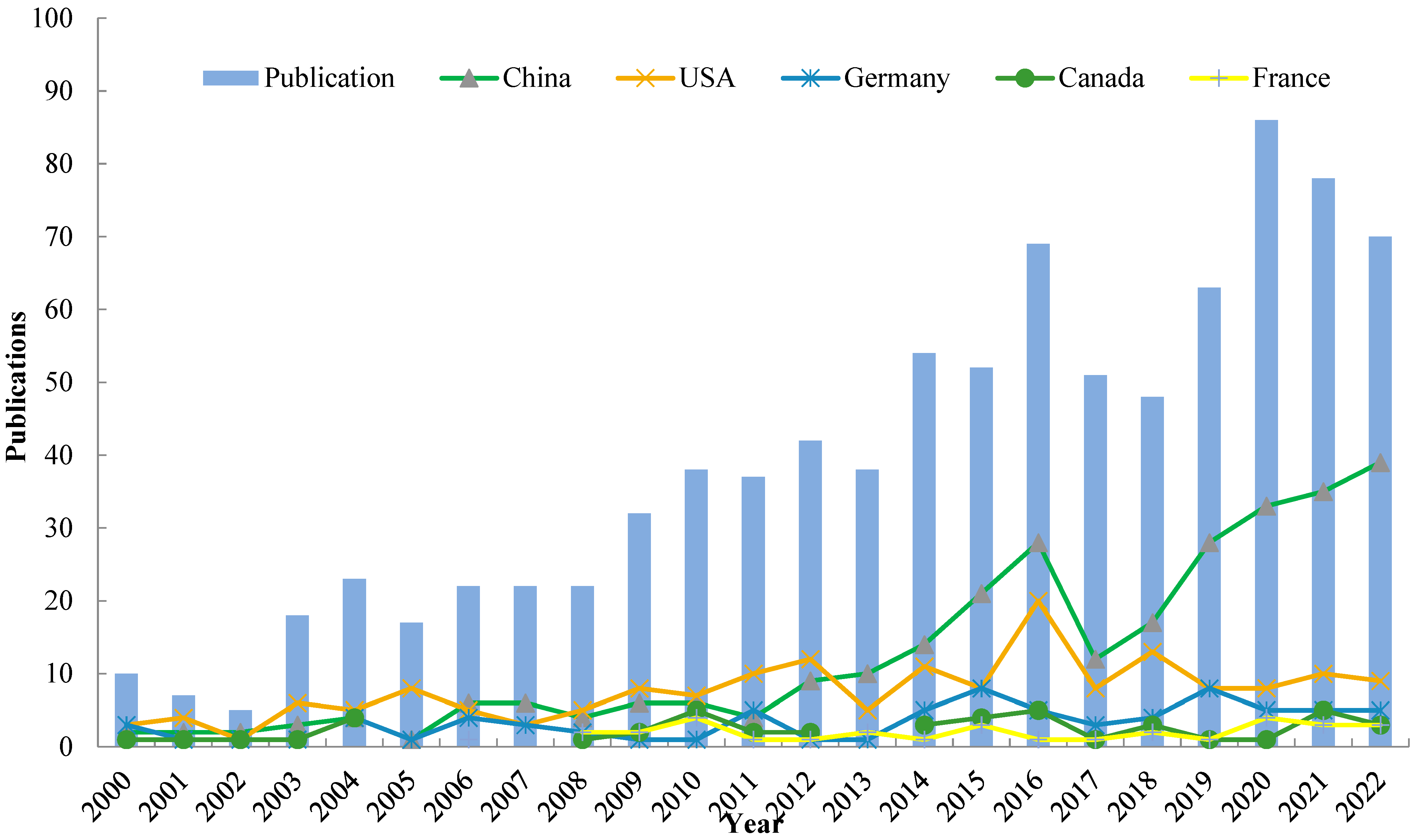
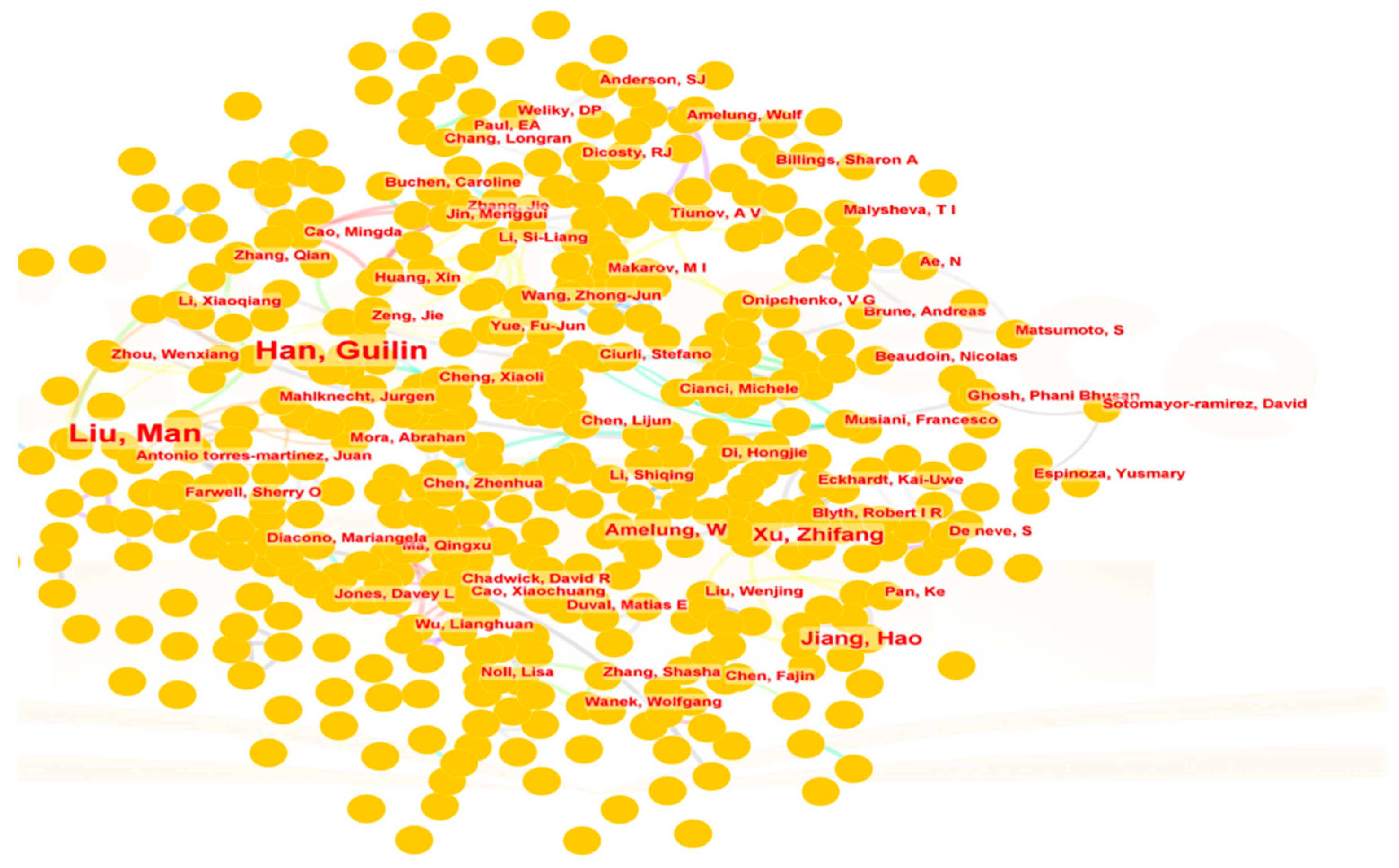
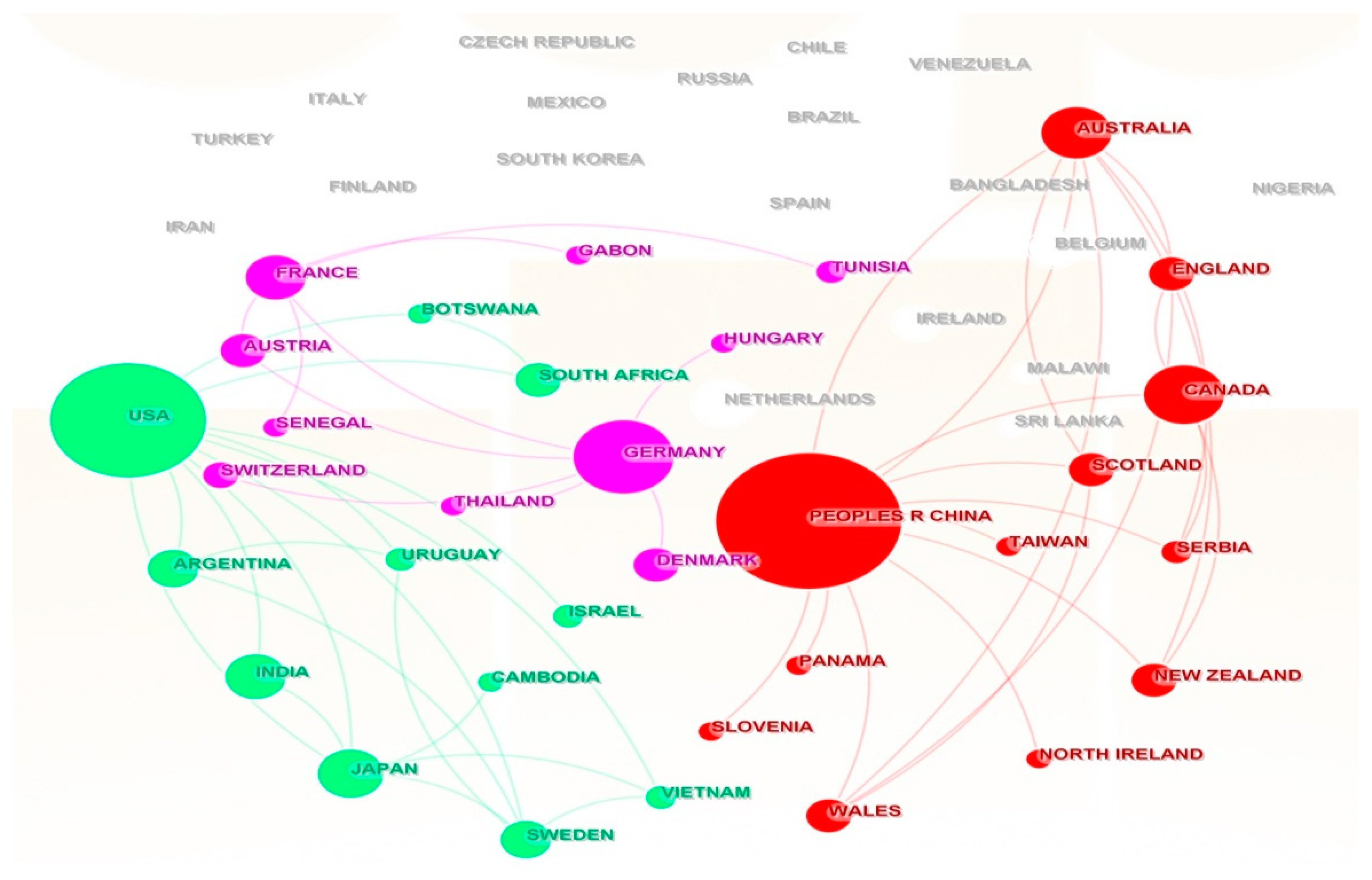
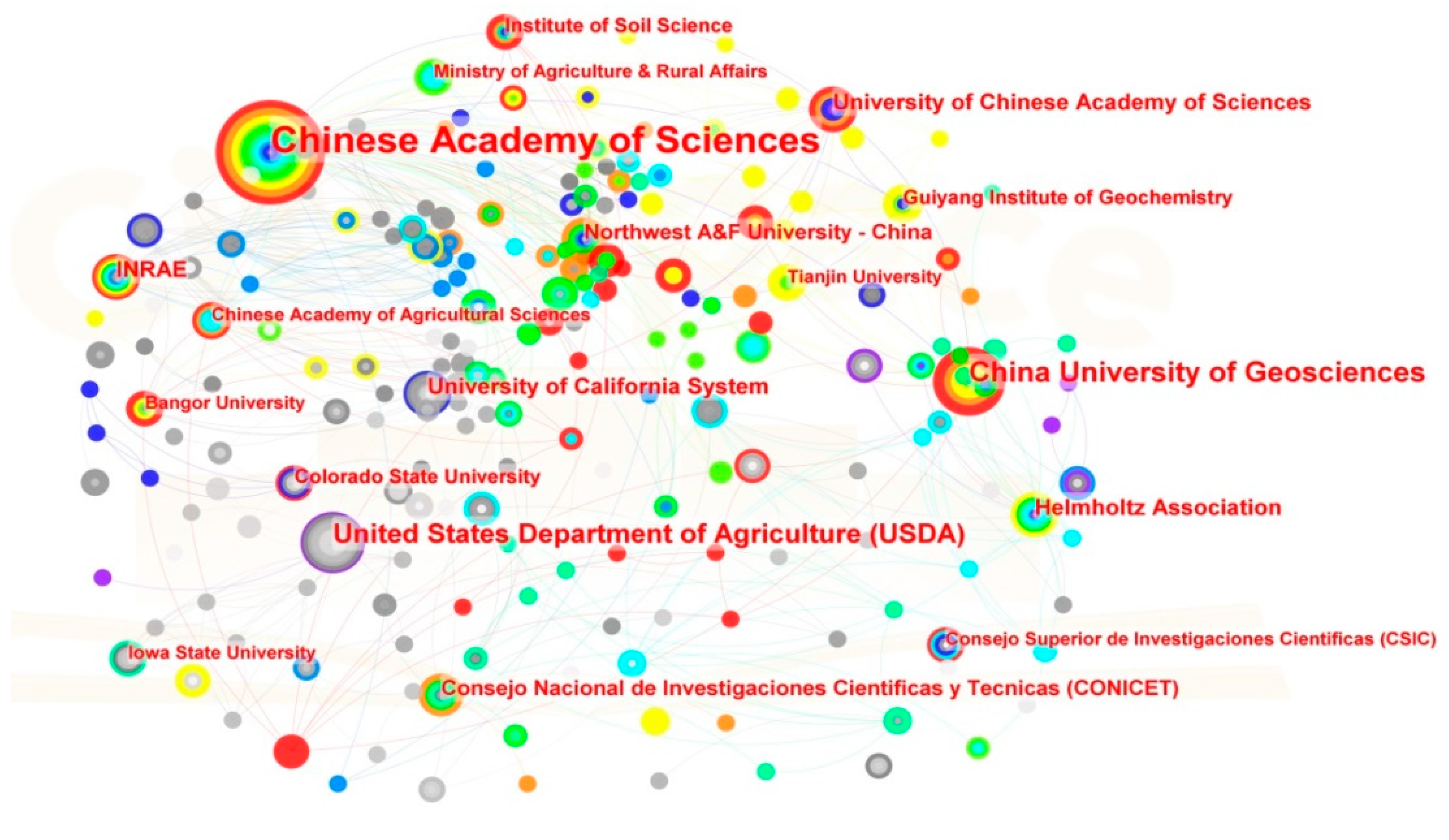
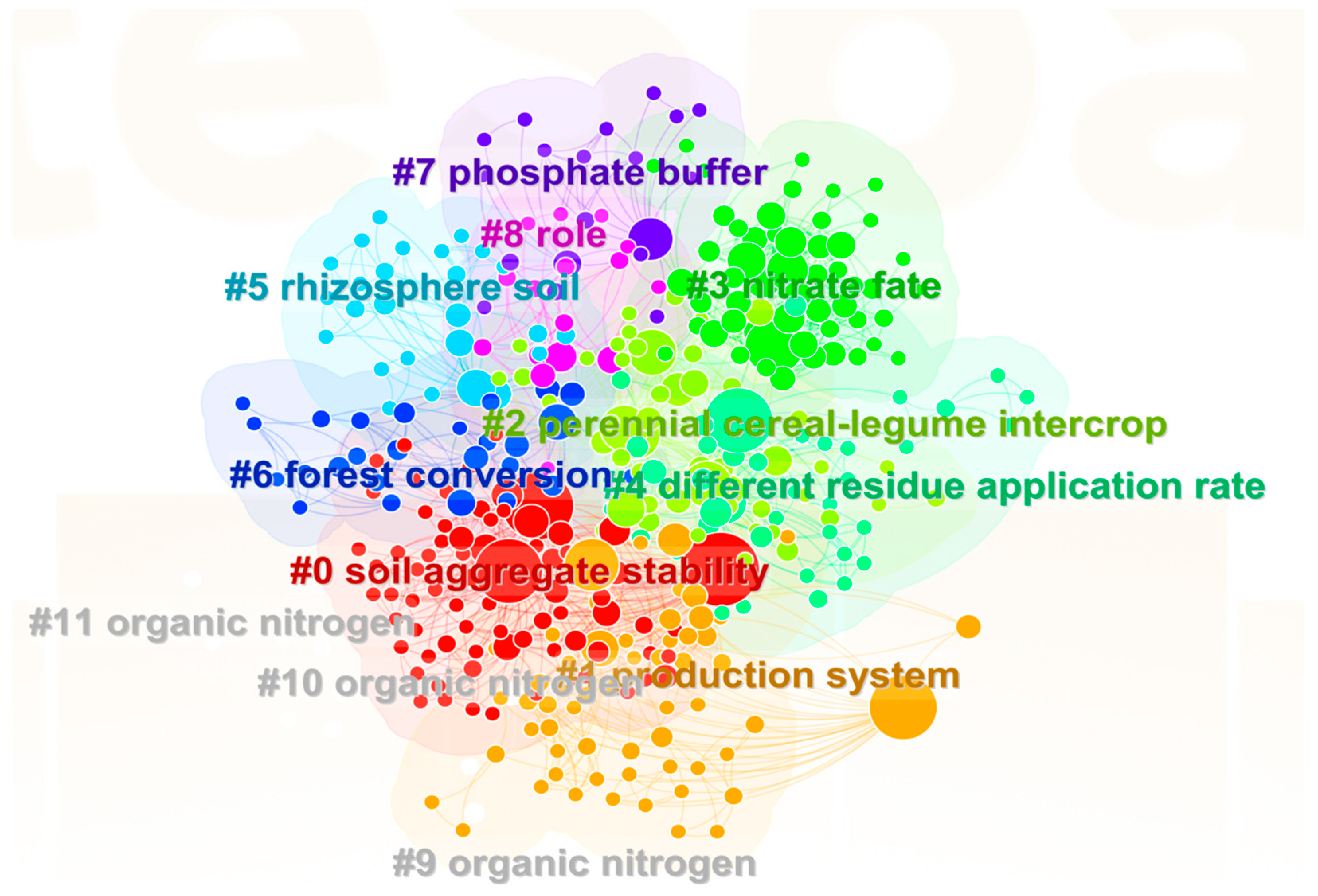
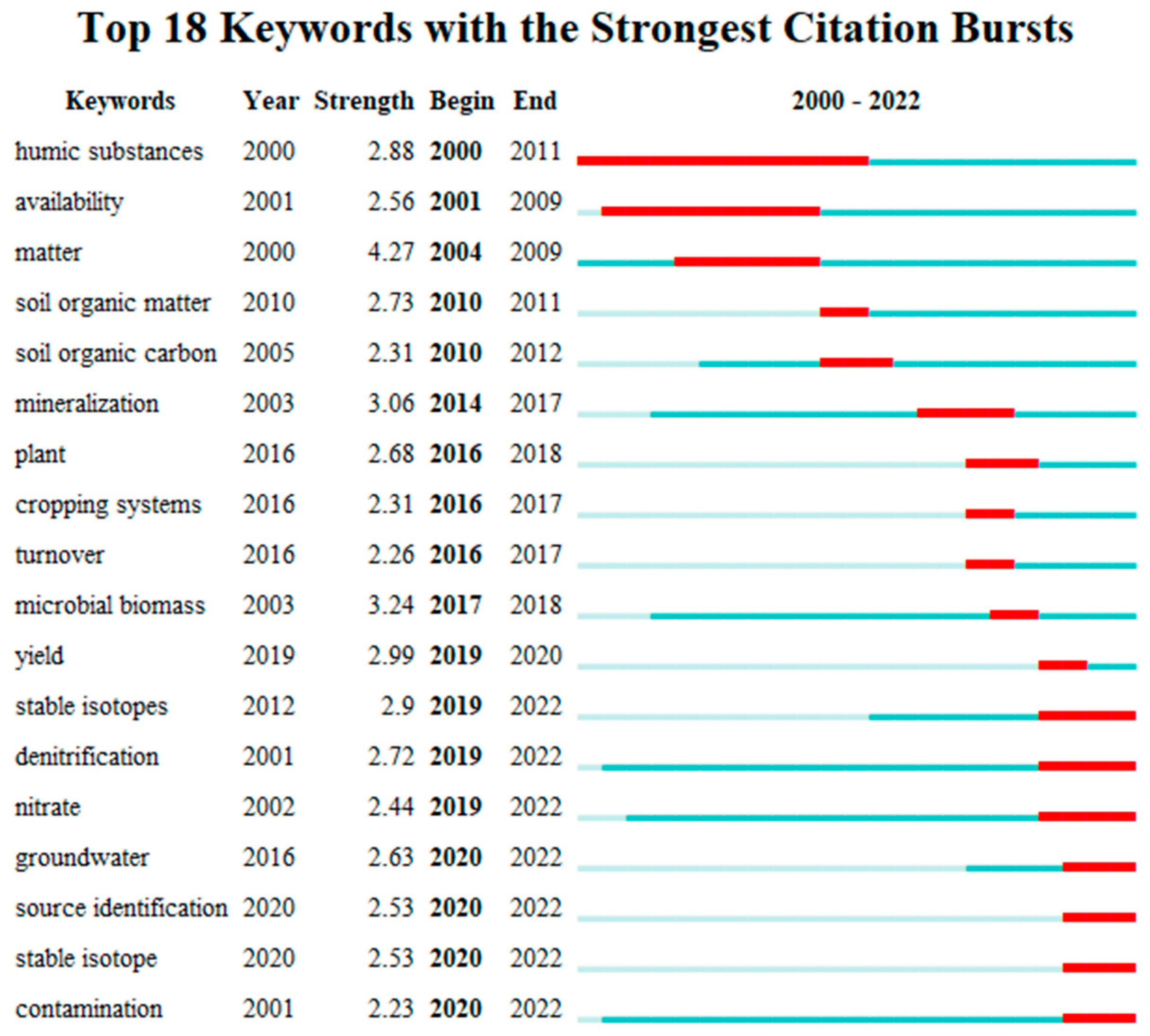
| Journals | Publications | TC/PC | Rate JCR | IF |
|---|---|---|---|---|
| Science of The Total Environment | 27 | 37.23 | 0.35 Q1 | 10.237 |
| Geoderma | 26 | 28.65 | 0.34 Q1 | 7.444 |
| Soil Biology Biochemistry | 26 | 23.26. | 0.34 Q1 | 9.956 |
| Plant and Soil | 22 | 22.06 | 0.28 Q1 | 5.44 |
| Agriculture Ecosystems Environment | 20 | 21.38 | 0.26 Q1 | 7.089 |
| The Journal of Applied Ecology | 20 | 19.29 | 0.26 CSCD | * |
| Biogeochemistry | 18 | 18.75 | 0.23 Q1 | 5.709 |
| Biogeochemistry Dordrecht | 18 | 17.63 | 0.23 CSCD | * |
| Catena | 18 | 15.96 | 0.23 Q1 | 6.497 |
| Yingyong Shengtai Xuebao | 18 | 12.13 | 0.23 CSCD | * |
| Soil Science Society of America Journal | 17 | 10.03 | 0.22 Q3 | 3.564 |
| Soil Tillage Research | 17 | 9.45 | 0.22 Q1 | 7.829 |
| Huanjing Kexue | 15 | 9.12 | 0.19 CSCD | * |
| Environmental Science | 13 | 8.76 | 0.17 CSCD | * |
| Nutrient Cycling in Agroecosystems | 13 | 8.29 | 0.17 Q2 | 4.504 |
| Scientia Agricultura Sinica | 13 | 7.34 | 0.17 CSCD | * |
| Communications In Soil Science and Plant Analysis | 11 | 6.58 | 0.14 Q3 | 1.608 |
| Journal Of Plant Nutrition and Fertitizer | 11 | 5.78 | 0.14 CSCD | * |
| Archives Of Agronomy and Soil Science | 10 | 4.38 | 0.13 Q2 | 2.157 |
| Chinese Journal af Applied Ecology | 10 | 3.54 | 0.13 CSCD | * |
| Title | Author | Journal | Year | Citations |
|---|---|---|---|---|
| Long-term effects of organic amendments on soil fertility. | Diacono, Mariangela; Montemurro, Francesco | Agronomy For Sustainable Development | 2010 | 932 |
| Ecosystem carbon loss with woody plant invasion of grasslands | Jackson, RB; Banner, JL; Jobbagy, EG; | Nature | 2002 | 804 |
| How does fire affect the nature and stability of soil organic nitrogen and carbon? | Knicker, Heike | Biogeochemistry | 2007 | 607 |
| The Ecology of Soil Carbon: Pools, Vulnerabilities, and Biotic and Abiotic Controls | Jackson, Robert B.; Lajtha, Kate; Crow, Susan E.; Hugelius, Gustaf; Kramer, Marc G.; Pineiro, Gervasio | Annual Review Of Ecology, Evolution, And Systematics | 2017 | 441 |
| Influences of continuous grazing and livestock exclusion on soil properties in a degraded sandy grassland, Inner Mongolia, northern China | Su, YZ; Li, YL; Cui, HY; Zhao, WZ | Catena | 2005 | 412 |
| Pathways of Grazing Effects on Soil Organic Carbon and Nitrogen | Pineiro, Gervasio; Paruelo, Jose M.; Oesterheld, Martin; Jobbagy, Esteban G. | Rangeland Ecology & Management | 2010 | 283 |
| Microbially derived inputs to soil organic matter: Are current estimates too low? | Simpson, Andre J.; Simpson, Myrna J.; Smith, Emma; Kelleher, Brian P. | Environmental Science & Technology | 2007 | 233 |
| Long-term fencing improved soil properties and soil organic carbon storage in an alpine swamp meadow of western China | Wu, Gao-Lin; Liu, Zhen-Heng; Zhang, Lei; Chen, Ji-Min; Hu, Tian-Ming | Plant and Soil | 2010 | 232 |
| Intercropping enhances soil carbon and nitrogen | Cong, Wen-Feng; Hoffland, Ellis; Li, Long; Six, Johan; Sun, Jian-Hao; Bao, Xing-Guo; | Global Change Biology | 2015 | 230 |
| Changes in Bacterial Community Structure of Agricultural Land Due to Long-Term Organic and Chemical Amendments | Chaudhry, Vasvi; Rehman, Ateequr; Mishra, Aradhana; Chauhan, Puneet Singh; Nautiyal, Chandra Shekhar | Microbial Ecology | 2012 | 223 |
Disclaimer/Publisher’s Note: The statements, opinions and data contained in all publications are solely those of the individual author(s) and contributor(s) and not of MDPI and/or the editor(s). MDPI and/or the editor(s) disclaim responsibility for any injury to people or property resulting from any ideas, methods, instructions or products referred to in the content. |
© 2023 by the authors. Licensee MDPI, Basel, Switzerland. This article is an open access article distributed under the terms and conditions of the Creative Commons Attribution (CC BY) license (https://creativecommons.org/licenses/by/4.0/).
Share and Cite
Chen, S.; Jiang, C.; Wang, H.; Bai, Y.; Jiang, C. Trends in Research on Soil Organic Nitrogen over the Past 20 Years. Forests 2023, 14, 1883. https://doi.org/10.3390/f14091883
Chen S, Jiang C, Wang H, Bai Y, Jiang C. Trends in Research on Soil Organic Nitrogen over the Past 20 Years. Forests. 2023; 14(9):1883. https://doi.org/10.3390/f14091883
Chicago/Turabian StyleChen, Shiyou, Chunqian Jiang, Hui Wang, Yanfeng Bai, and Chunwu Jiang. 2023. "Trends in Research on Soil Organic Nitrogen over the Past 20 Years" Forests 14, no. 9: 1883. https://doi.org/10.3390/f14091883
APA StyleChen, S., Jiang, C., Wang, H., Bai, Y., & Jiang, C. (2023). Trends in Research on Soil Organic Nitrogen over the Past 20 Years. Forests, 14(9), 1883. https://doi.org/10.3390/f14091883





